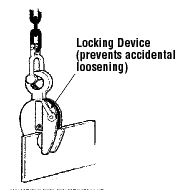Materials Handling - Plate Clamp Inspection and Use
On this page
How should you inspect the exterior of a clamp?
Back to topFollow the clamp manufacturers' maintenance recommendations.
- Inspect internal and external surfaces for forging or weld fractures, wear and distortion.
- Check all pin holes for wear.
- Inspect the throat (clamp opening) width. At zero grip, the cam should be in full contact with the pad.
- Measure the width of the throat. If the measurement at the base, where the pad is located, is greater than at the top, the body has been overloaded. Replace the clamp, tag the defective clamp, and remove it from service.

How should you inspect the internal parts of the clamp?
Back to top- Soak the clamp overnight in a degreasing solvent to remove all dirt and grease that prevents proper inspection of components. Degreasing solvents should be used in appropriately well-ventilated areas. Handle the wet clamp parts while wearing gloves made of a material that is chemically resistant to the solvent.
- Remove the body pins or bolts and slide out the complete internal mechanism.
- Check each body pin or bolt for wear or bending due to overloading.
- Check each spacer, rivet, bolt or internal part for play or wear.
- Replace any worn, distorted or defective part.
What should you know about the spring, cam, lock and pads?
Back to top- The cam spring should be strong enough to hold the cam against the pad.
- The locking spring should give initial pressure at near-zero grip without material in the clamp.
- There should be "definite tension" in the locked position.
- The spring should not be bent or distorted.
- The lock assembly should rotate freely without binding and must rest fully on the stop pin.

- Cams and pads are vital parts of a clamp and are exposed to wear. Use only on one size plate thickness will cause wear only in one area of the cam working surface. Replacement is required sooner than when a cam is used to handle different plate thicknesses.
- Examine the cam surface. If the teeth are flattened by 50% or more, replace the cam and pad.
- Teeth must be sharp and free of foreign material.
- The shackle must not show signs of elongation or wear.
How should you use plate clamps safely?
Back to top- Select the correct clamp for the job. There are clamps for vertical, horizontal or universal (multidirectional) lifting. Clamps are also rated for the thickness of the plate they are designed to lift.
- Refer to the manufacturer's operating instructions.
- Inspect clamps visually before each lift.
- Lift one plate at a time unless using clamps and methods approved otherwise.
- Use two or more clamps to balance a long or flexible load.
- Install the clamp (or clamps) over the centre of gravity of the plate.
- When using a vertical type of plate clamp, use a locking device to prevent unintentional loosening.
- Use horizontal types of plate clamps in pairs.
- Use clamps within their rated capacity and flange width.
- Lock a clamp closed before lifting a load.
- Use a sling between the clamp and the crane or hoist hook.
- Use non-marring (rubber pad) clamps in pairs when lifting finished and polished plates.
- Lift smoothly; avoid jolts.
- If the use of a tag line is necessary, attach it to the clamp before lifting the plate.


What should you avoid when using plate clamps?
Back to top- Do not lift over workers.
- Do not stand near a load.
- Position yourself away from and fully clear of the load. Remember to also consider how the load might fall when it lands.
- Do not overload or underload a clamp.
- Do not lift from the side with a vertical clamp.
- Do not lift more than one plate at a time with a vertical clamp.
- Do not lift a plate from the bottom of a plate stack.
- Do not drag the load using the plate clamp.
- Do not grind, weld or modify a clamp.
- Do not use a clamp having a minimum jaw opening larger than the thickness of the load.
- Do not leave suspended loads unattended.
- Fact sheet confirmed current: 2025-07-24
- Fact sheet last revised: 2019-05-15

